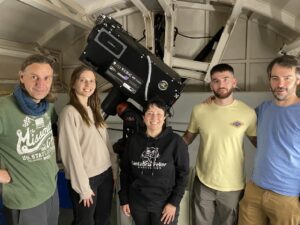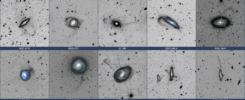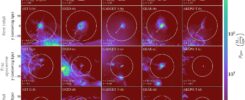A hands-on training campaign with the iSIM-170 camera brings the ARRAKIHS mission closer to readiness, validating systems and protocols ahead of launch.

As part of preparations for ESA’s ARRAKIHS mission, team members recently completed a key technical training campaign at the Javalambre Astrophysical Observatory (OAJ) in Spain. The purpose of the activity was the hands-on operation of the iSIM-170 camera demonstrator — a ground-based version of the instrument that will be flown on board the ARRAKIHS satellite.
The training brought together representatives from multiple institutions involved in the mission, including the Institute of Physics of Cantabria (IFCA, CSIC-UC), the University of Florida, the Institute of Astrophysics of Andalucia (IAA-CSIC), and the technology company Satlantis, which developed the camera.
Preparing for Space: Training with the iSIM-170 Demonstrator
Throughout the campaign, operators received practical instruction on how to remotely operate the dual-telescope camera system. This ground-based prototype closely replicates the functionality and design of the flight model, making it an essential tool for testing and validation.
These tests were crucial to verifying operational protocols such as image acquisition, data calibration, and transmission — all in conditions that replicate the mission’s future requirements in orbit. The iSIM-170 instrument, developed by Satlantis and equipped with a multiband system operating in both visible and near-infrared wavelengths, provides high-resolution imagery and stability from Earth, simulating the performance expected in space.
“This is a unique opportunity to gain direct experience with the system and ensure we’re fully prepared for the mission phase,” said Rosa M. Domínguez, one of the operators participating in the training. “The knowledge we’re acquiring now will directly contribute to the success of ARRAKIHS once in orbit.”
A Mission in Preparation
Currently in its definition phase, ARRAKIHS aims to study dark matter by observing faint stellar structures in nearby galaxies. With launch expected around 2030, the mission is progressing through key milestones — including campaigns like this one.
Building Operational Readiness
The Javalambre campaign was essential to ensure both the camera system and mission operators are ready for flight. It helped refine protocols, test performance under real conditions, and anticipate technical challenges.
The observations during this session were carried out by Rosa M. Domínguez (IFCA, CSIC-UC), Alejandro Camazón (University of Florida), Joanna Sakowska (IAA-CSIC), and Santiago Serrano (Satlantis), with support from OAJ operator Miguel Chioare.
By combining hands-on expertise with advanced engineering, ARRAKIHS continues to make steady progress toward uncovering the secrets of the dark Universe.


